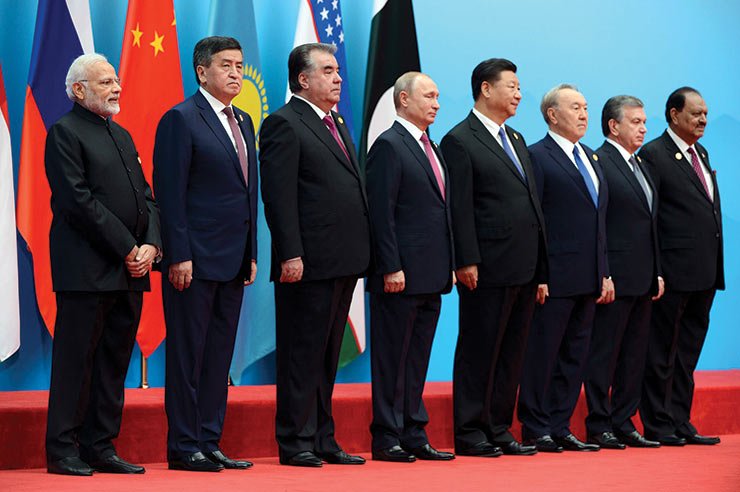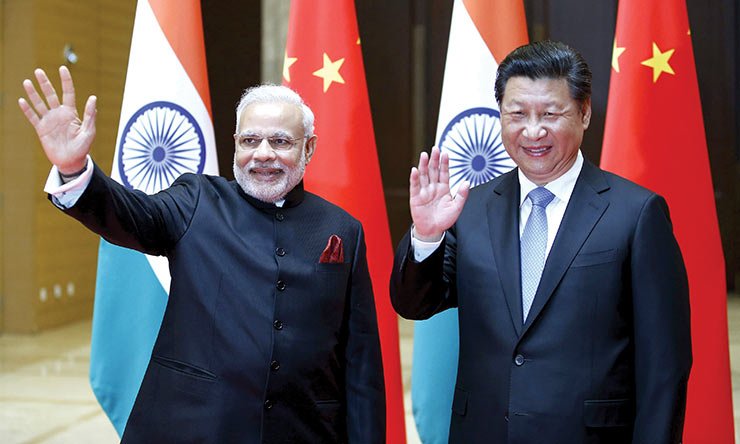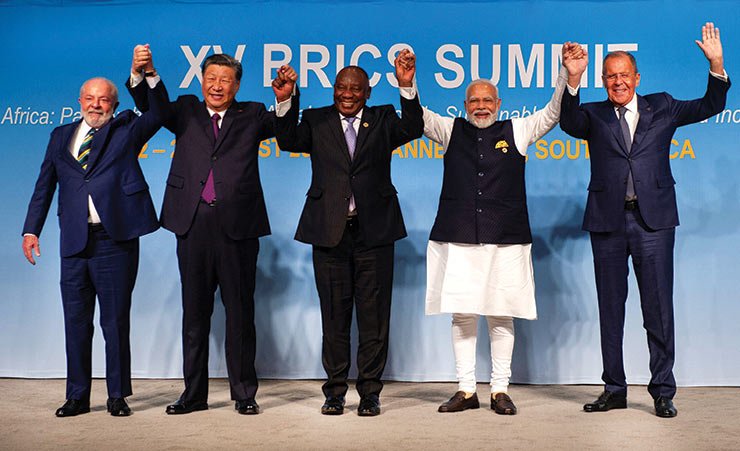
The string of diplomatic events, with India as an important member, started with the Shanghai Cooperation Organisation’s (SCO) annual summit hosted by India virtually in July earlier. The SCO meeting was held days after PM Modi’s visit to the U.S. One of the reasons cited for the virtual format was that given the current state of India’s relations with both China and Pakistan, the environment was not appropriate for an in-person meeting. In fact the GoI did not want to create another unsavoury scene as was created at the G-20 Goa Tourism Roundtable.
Since, SCO right from the start has been seen as a Chinese dominated forum, this year too India was not able to achieve anything substantial at the SCO summit 2023.
Next in the diplomatic marathon came the BRICS Summit at Johannesburg, South Africa in August. Once more, at BRICS the Indo-Chinese race to regional supremacy came to the fore. Although more than 40 heads of state were present in Jo’burg, yet the major absences in the form of Vladimir Putin and a surprising absence from Chinese President Xi Jinping during a crucial session, took its toll. In addition China was able to play a more substantial role in getting Iran the BRICS membership. Also India’s efforts to work out a more orderly payment system in place of the Dollar could be described as a no cropper.
Another key takeaway from the BRICS summit was that both countries withdrew thousands of deployed troops from the border. Both released a joint statement leading up to the event, and they resumed talks with de-escalation as the goal. In addition, India was able to block adversary Pakistan’s entry to the bloc.
Though, for BRICS to become more relevant and rise-up as a forum for the Global South, both India and China will have to resolve their long-standing border issue first and then work collaboratively to tackle tough global issues. But it may not be possible, as both countries want to emerge as “voice of the Global South”.
However, Prime Minister Modi as a leader of the Global South and keeping in mind India’s strategic and regional priorities, in spite of his heavy commitment to the G-20 Summit, undertook a whirlwind tour of the Indonesian capital Jakarta, in order to attend the ASEAN and East Asia Summit.

This shows the priorities of the GoI at both the regional and global levels. On one hand India was hosting the prestigious G-20 Summit but on the other hand it didn’t overlooked its regional priorities and strategy. At Jakarta, Prime Minister Modi made it a point to meet with every regional counterpart present at the summit. He said that it was a matter of pride for him to co-chair the ASEAN-India Summit while highlighting India-Indonesia partnership entering its fourth decade.
Modi’s comments on the South China Sea issue also coincided with China’s territorial claims in the region, particularly as it presented its latest “standard map of China” including many neighbours as part of China. This move raised global concerns regarding China’s military assertiveness and territorial claims in the South China Sea. However, Modi reiterated the conviction that the current era should be defined by dialogue and diplomacy, not conflict or war, in addressing geopolitical disputes. Overall Xi Jinping’s and Narendra Modi’s competition over leadership status of the Global South, were more at play during all these diplomatic outreach by Mr Modi.
In addition, the release of China’s new map was aimed at fulfilling this objective and prompted speculation about its impact on the G-20 summit. Though the true reason for Xi’s unwillingness to visit India stemmed from the fact that a successful joint communiqué from the summit would have lent credence to India emerging as a leader of the Global South, which actually happened. Finally, Mr Modi was able to project both India and himself as a country and a leader with heft. But at he same time, diplomatic niceties and victories apart, we also should take a closer look at how two neighbours perform at different indices and military power.
SCO right from the start has been seen as a Chinese dominated forum, and this year too, India was not able to achieve anything substantial at the SCO summit 2023
Noted economist, Professor Amartya Sen while speaking at Harvard, sometime back argued that it is not the nature of government that is the main factor in China’s success but its investment in health and education that provided fuel to its explosive growth. India he said has under-invested in these key areas and hence its economic growth is poorly supported by quality human capital. Professor Sen was critical of the suggestion that countries could grow economically first and then invest in education later saying that it was the reverse that is true.
If we go by the figures released by the World Bank, then it would be clear that India stands behind China in GDP with USD 4.2 trillion, while China boasts a GDP of USD 10.1 trillion, India lags behind China in literacy rates, which at 74% is well below China’s at 95% (in 2010). The case of health sector is no different; today India’s life expectancy is 11 years below that of China.
In both countries, the service sector is emerging as a major propellant of development, but India has been unable to provide a manufacturing platform par excellence to MNCs like China did and that’s why after the Covid pandemic, the shift in manufacturing base of MNCs from China was towards, Vietnam, Cambodia, Malaysia etc. instead of India.

South Africa
Human Development Index – HDI takes into consideration three parameters to judge a country’s development performance. These are PCI, literacy levels, and nutritional levels. Trends show that China is overtaking India in every HDI ranking.
However, on a positive note 80% of India’s population is younger than 50. Less than two-thirds of Chinese people are younger than 50. Thus, India is a country primed to work. More than two-thirds of all Indians are between the ages of 15 and 59. The country’s ratio of children and retirees to working-age adults is remarkably low. But India has not able to reap this “demographic dividend” and this could instead become a disaster. In recent years, India has squeaked past China to claim the title of fastest-growing major economy. But it has never expanded fast enough to produce sufficient formal employment for everyone.
These data supports Amartya Sen’s basic premise that India’s low literacy rates and poor health outcomes as compared to China’s may explain a big part of the disparity in development between the two countries.
Professor Amartya Sen while speaking at Harvard, sometime back argued that it is not the nature of government that is the main factor in China’s success but its investment in health and education that provided fuel to its explosive growth
If we make a comparison of the defence spending and capability of the two countries, it becomes evident that for the fiscal year 2022 China’s annual defence budget was 1.45 trillion dollars, a 7.1 per cent increase over the previous year. This means that China’s defence budget was more than three times as much as India’s, which amounted to 5.25 lakh crore (about USD 70 billion) in 2022. The increase in China’s defence budget spending will majorly impact India. The increase in spending may result in a greater gap between Chinese and Indian capabilities in the military. In conjunction with China’s modernisation push and its emphasis on the use of high-tech technology within the army, India has a significant deficit to fill in the area of hard power, too.
The active military personnel of China and India stand at 2,185,000 and 1,455,550 respectively. As far as hardware is concerned, India has 4,614 tanks, as compared to China’s 5,750; China possesses 14,130 armoured fighting vehicles, as compared to India’s 8,600; in air power China possesses 4,630 aircrafts as compared to India’s 2,263, of which, China has 1,049 fighter aircraft, while India has only 173; India has 405 multi-role aircraft, while Chinese have 1,130 of such aircrafts; however, both have a parity in attack aircraft with 120 each. Further China possesses 1,355 helicopters while India has only 729 helicopters. In Naval capacity China leads with 4 aircraft carriers, of which India has only 1; as compared to 38 destroyers possessed by China, India only has 11 of such destroyers ships; the number of frigates possessed by Chinese Navy is 54 as compared to 13 possessed by India; same goes for submarines – in comparison to 74 Chinese submarines India possesses only 16 submarines.
China matched its explosive economic growth with startling military modernisation and assertiveness. Its long-standing military doctrine and terrain advantages means it relies heavily on quality military infrastructure on the Tibetan plateau and it has accelerated the pace of those infrastructure upgrades and expansion.
Overall apart from diplomatic and sentimental wins, India still has a lot of catching-up with China, if it really wants to be seen and heard as the leader of the Global South, then it will have to perform better in virtually every domain, from economic to technological, from scientific to military and above all as a dependable ally to its other neighbours.
–The writer is a political commentator based in New Delhi. He can be contacted on www.asadmirza.in. The views expressed are of the writer and do not necessarily reflect the views of Raksha Anirveda















